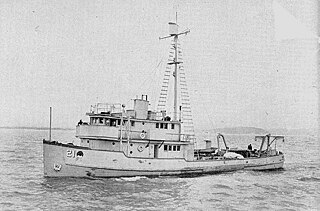
The Finnish Navy is one of the branches of the Finnish Defence Forces. The navy employs 2,300 people and about 4,300 conscripts are trained each year. Finnish Navy vessels are given the ship prefix "FNS", short for "Finnish Navy ship", but this is not used in Finnish language contexts. The Finnish Navy also includes coastal forces and coastal artillery.
USS Bunting (AMc-7) was a coastal minesweeper in the United States Navy. She was named after the bunting, a seed-eating bird intermediate in size between starlings and finches.
USS Goshawk (AM-79), was a Goshawk class minesweeper built in 1919 as the steel-hulled fishing trawler M/V Penobscot by the Foundation (Marine) Co., Savannah, Georgia, for Mr. W. F. Henningsen, Seattle, Washington.
USS Pipit (AMc-1) was a Pipit-class coastal minesweeper acquired by the United States Navy for use in World War II. Her task was to clear minefields in coastal waterways.
USS Plover (AMc-3) was a Pipit-class coastal minesweeper acquired by the United States Navy for use in World War II. Her task was to clear minefields in coastal waterways.
USS Agile (AMc-111) was an Agile-class coastal minesweeper acquired by the United States Navy for the dangerous task of removing mines from minefields laid in the water to prevent ships from passing.
USS Radiant (AMc-99) was an Accentor-class coastal minesweeper acquired by the U.S. Navy for the dangerous task of removing mines from minefields laid in the water to prevent ships from passing.

USS Liberator (AMc-87) was an Accentor-class coastal minesweeper acquired by the U.S. Navy for the dangerous task of removing mines from minefields laid in the water to prevent ships from passing.
USS Phoebe (AMc-57) was a coastal minesweeper acquired by the U.S. Navy for the dangerous task of removing mines from minefields laid in the water to prevent ships from passing.
USS Pintail (AMc-17) was a coastal minesweeper acquired by the U.S. Navy for the dangerous task of removing mines from minefields laid in the water to prevent ships from passing.
USS Nightingale (AMc-149) was a coastal minesweeper acquired by the U.S. Navy for the dangerous task of removing mines from minefields laid in the water to prevent ships from passing.
USS Grosbeak (AMc-19) was a Grosbeak-class coastal minesweeper acquired by the U.S. Navy for the dangerous task of removing mines from minefields laid in the water to prevent ships from passing.
USS Crow (AMc-20) was a Crow-class coastal minesweeper acquired by the U.S. Navy for the dangerous task of removing mines from minefields laid in the water to prevent ships from passing.

USS Killdeer (AMc-21) was a unique coastal minesweeper acquired by the U.S. Navy for the dangerous task of removing mines from minefields laid in the water to prevent ships from passing.
USS Blue Jay (AMc-23) was a coastal minesweeper acquired by the U.S. Navy during World War II for the dangerous task of removing mines from minefields laid in the water to prevent ships from passing.
USS Humming Bird (AMc-26) was a unique coastal minesweeper acquired by the U.S. Navy for the dangerous task of removing mines from minefields laid in the water to prevent ships from passing.

USS Road Runner (AMc-35) was a coastal minesweeper acquired by the U.S. Navy for the task of removing mines from minefields laid in the water to prevent ships from passing.
USS Marabout (AMc-50) was an Accentor-class coastal minesweeper acquired by the U.S. Navy for the dangerous task of removing mines from minefields laid in the water to prevent ships from passing.

USS YP-148 was a converted fishing vessel which served as an auxiliary patrol boat in the U.S. Navy during World War II.

Anderson & Cristofani was a wooden shipbuilding company in San Francisco, California. To support the World War 2 demand for ships Anderson & Cristofani shipyard switched over to military construction and built: US Navy APC coastal transports, tugboatss, Patrol Boats and Minesweepers. Founded by Walter Anderson and Alfred Christofani. Anderson & Cristofani was started the early 1870s building San Francisco Bay scow schooners, which they built till the mid 1930s. Anderson & Cristofani built pleasure craft and workboats. The boatyard was on Innes Avenue, in the India Basin, at Hunter's Point. Henry P. Anderson, a shipwright from Denmark first worked at Dircks' boatyard when her arrived in 1893. Anderson joined Alf Cristofani in 1926 to form the Anderson & Cristofani Boatyard. The Anderson & Cristofani boatyard closed in 1988 and was taken over by Allemand Brothers boat repair, run by Rene Flip Allemand and John Allemand, started in 1946. Allemand Brothers boatyard closed in 2002. The land sold to property developers, but no project was built. The city of San Francisco purchased the land in 1989. In 2014 the city started the planning for the India Basin Shoreline Park at the site. The boatyard was at 900 Innes Ave, San Francisco.




